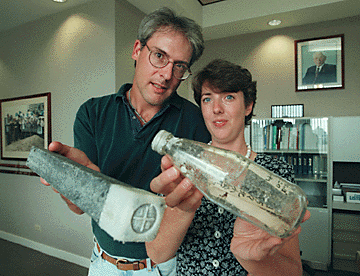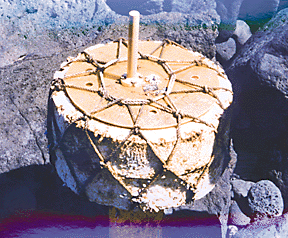


Beachcombers
find science buoy
from Japan
The device to track the flow of
By Helen Altonn
ocean garbage had been floating
at sea since the summer
of 1991
Star-BulletinBIG Islanders Rachael Stackhouse and Joe Sprinkel were exploring a remote rocky beach at Kapoho when they encountered a strange yellow device.
Across the top was written: School of Marine Science and Technology, Tokai University.
It's the only buoy that's turned up so far out of 18 released by Tokai scientists off Japan on July 20, 1991, to study the movements of ocean garbage, the discoverers said.
It is about 4 feet high, weighs 60 to 70 pounds and contains sensing instruments, Sprinkel said.
"I had to carry it about three miles," he said. "I first brought it to the jungle, covered it with leaves and came back for it a few days later."
The buoy was assumed lost
Stackhouse, who is studying anthropology at the University of Hawaii-Hilo, said she got on the Internet and looked for professors doing remote sensing at Tokai University in Japan. She was referred to Masahisa Kubota, a professor in the oceanography department.Kubota went to the Big Island in mid-December to collect the buoy and pack it up to return to Japan. Accompanying him were his family and Kohei Cho, chairperson for computer-assisted teaching at Tokai University. "They were excited because 17 others (buoys) are still out in the water floating around," Stackhouse said.

Sprinkel said the scientists tracked the buoy by satellite for about a year until the batteries in the instruments wore out."They had given it up for lost."
Stackhouse and Sprinkel were at the Tokai University Pacific Center in Honolulu Thursday to discuss their find at a teleconference.
They talked to delegates at the 7th Asian and Pacific University Presidents' Conference at Tokai University in Kumamoto, Japan.
Theory was close to reality
The presidents initiated the buoy project to address environmental concerns in the Pacific, said Motoyasu Miyata, senior researcher in Japan's Earth Science and Technology Organization and liaison for Japan science agencies at the University of Hawaii's International Pacific Research Center.Miyata said Kubota simulated the movement of ocean garbage from Japan in an experiment, and predicted the trash would converge about 10 miles north of Hawaii.
Discovery of the buoy Oct. 1 shows his "prediction at least was near," Miyata said. "In a sense, it's not so surprising it was found in the Hawaiian area. The distance is not so far.
"But we're quite lucky," he added. "The ocean is very vast. The probability of getting this on shore was very, very small."
Stackhouse and Sprinkel, a carpenter, said they comb the rugged coastline between Hilo and South Point as a hobby. "Lots of things seem to make it there," Sprinkel said. When the Japanese scientists visited last month, they spent most of a day looking at all the things the couple had found, he said.
"We kind of watch the weather, to see which way the tide is going, and we go out after high tide," Stackhouse said.
The joys of beachcombing
They collect shells, glass fishing floats and bottles of all kinds. Their prize glass ball is a purple one, said to be from the emperor's fishing fleet, Stackhouse said.They also haul a lot of odd things to their Keaau home from the coast. Their "lawn art" includes a channel marker. They also picked up several property markers that floated to the Big Island from Japan.
Stackhouse's son, Dylan, 11, found a bottle last May with a note dated "Tokyo 1992." A card enclosed for a reply had partially deteriorated but an address remained. They're still trying to locate the sender.
"Most things we see are fishing-related," Sprinkel said, but they've also found light bulbs, medical paraphernalia such as intravenous bottles, and even a piece of an airplane.
"Searching is the most fun," Stackhouse said. "We take kids and it's like a treasure hunt. If one person finds one (glass ball), we all get excited."